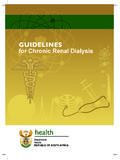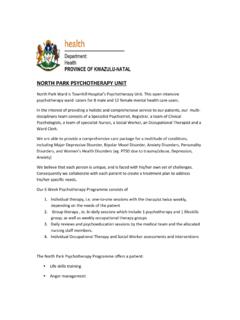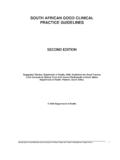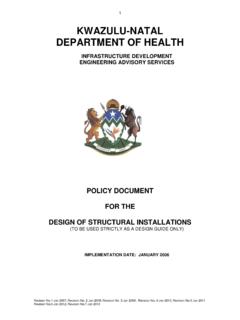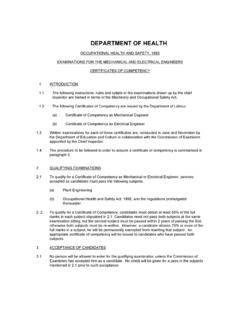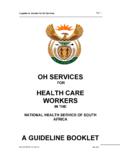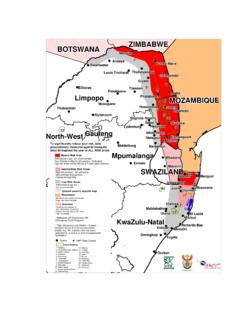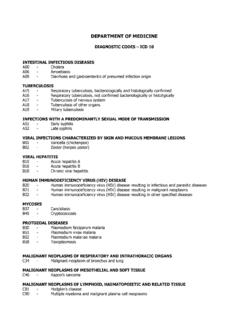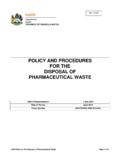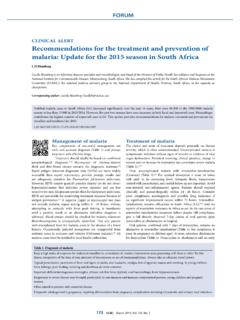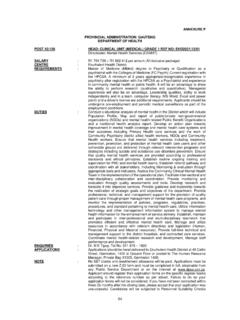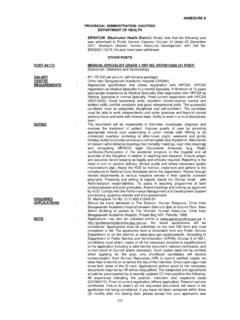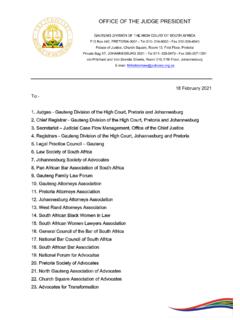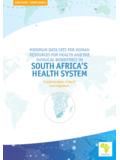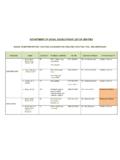Transcription of The comprehensive primary health care services package
1 1 DRAFT: 5 THE comprehensive primary health CARE services package 2 TABLE OF CONTENT PAGE - Summary 4 - Acknowledgements 6 - Introduction 8 - Description of services 12 - package 15 1. District / Community services 16 Intersectoral 17 Marketing messages 19 Protocol Promotive health services 20 Environmental health 21 Home-based care 22 Workplace 23 services for School age children 24 Rehabilitation services 25 2. Clinics / Mobiles 26 Preventative 27 Curative 28 Adult service point 29 Ante-Natal Care 30 Post-natal services 31 Family Planning 32 Sexual and other abuse 33 Medical TOPs 33 Cervical cancer screening 34 Curative : Acute 35 STDs 37 HIV/AIDS 38 TB 39 Environmental services 40 Rehabilitation services 40 3 Fast-queue / Repeat service point 41 Chronic diseases 43 Mental health 44 Walk through service 45 Protocol violence 45 3.
2 Community health Centre 46 Clinic + Paediatric Reproductive health : Ante-natal 48 TOP 49 Other reproductive (including Infertility) 50 Adult curative Chronic Disease 51 TB 52 HIV / AIDS 53 Other Curative 53 Mental health 54 Oral health 55 Physical Disabilities 56 Environmental health 57 Occupational health 58 Casualty 58 Maternity 59 Appendix 1: Resources Implications - Cost - Staff - Facilities - Appendix 2: Report from consultation process 4 THE comprehensive primary health CARE SERVICE package OVERVIEW Please find enclosed a copy of the latest draft of the comprehensive primary health Care Service package of PHC services .
3 The purpose of this package is, in the perspective of equity, to define a minimum basket of PHC services which within a period of 3 to 5 years will be common to the whole country. This package would help to quantify requirements in terms of staffing, infrastructure, equipment and financial resources. It is hoped that this quantification would then assist health managers negotiating an appropriate budget with their provincial authorities. Development of this package was commissioned to the Centre for health Policy at Wits University and the Centre for health Research and Development at the University of the Free State, with funding from the health Systems Trust. The development of the package built on the work on Needs/Norms from the Centre for health Policy and on the initial package developed by the gauteng health department . The package went through a process of consultation initially with managers and providers in gauteng and the Free State, then with all directorates in the department of health .
4 A series of consultation workshops were held in eight provinces. Comments from all these consultation process have been integrated in the package to form this latest draft. The package is presented as follows : an introduction explaining the background to the package , the package itself with an explanation of the different levels of services presented, a list of services and their components with suggested prioritisation. The two appendixes cover the following : Appendix 1 is a presentation of the envisaged resources implications : financial, staffing and facilities; Appendix 2 is a report from the provincial consultation process with its ensuing recommendations. At this stage, it is worth noting the following : a) the package is still in the form of a listing on paper. Its real feasibility, and the consequent prioritisation, can only be assessed through a thorough piloting process.
5 B) the resource implications have been assessed through the adaptation of the needs/norms quantification model. It is essential to firm up, through piloting, the norms and standards underlying the model as well as the costing. c) implementation of the package carries with it a number of human resources implications : categories of staff for specific level of services , code of practice . This will need to be looked at in the very near future to enable appropriate piloting. 5 6 ACKNOWLEDGEMENTS : Financial Assistance for the development of the package was provided by the health Systems Trust, and for the consultation in provinces by the European Union. The research work was carried out by Emmanuelle Daviaud and Jorge Cabral from the Centre for health Policy at Wits University and by Abdul Elgoni from the Centre for health Systems Research and Development at the University of the Free State.
6 The consultation workshops were run by Ms Assy Moraka from the department of health and the two principal researchers. Core- package initiative was co-ordinated for the department of health by Dr Louis Classens , Ms Myrah Mashigo and Ms Assy Moraka . The research project benefited greatly from the inputs of a great number of people that we wish to thank here : a) Peter Barron for his on-going support and advice, b) Laetitia Rispel for her project on Needs/Norms c) Carol Marshall for the gauteng package department of health : a) Yogan Pillay b) Ms Kotzenberg c) and all the directorates who have contributed most useful comments and suggestions gauteng : a) Carol Marshall, Sandy Schneider, Ruth Zwi, Marian Ahern, Liz Floyd, Adrian Myburgh b) Cheryl Goldstone c) Helen Rees Free State : a) Vinay Panday, Moeder Khokho, Beth Engelbrecht, Nick Van Zyl Others: 7 a) Helen Schneider, Tennysson Lee, Lucy Gilson, Sharon Fonn b) David Harrisson, David McCoy, the Child health Policy Institute c) Neil Martinson, Colin Wright, Mapula Peri, Koerbie Van der Walt As well as all the health managers and providers in the eight provinces who participated in a very informative way in the consultation process.
7 Finally, thanks to Maureen Phungwayo and Bethuel Masetla for the administrative support. 8 THE comprehensive primary health CARE services package INTRODUCTION At the request of the department of health , a comprehensive primary health Care Service package of primary health Care services has been developed by the Centre for health Policy (University of the Witswatersrand) and the Centre for health Systems Research and Development (Free State University). It covers services rendered at community level, clinic/mobile level and Community health Centre level. These represent the services which should be rendered, for in order PHC services to be fully comprehensive . However it is clear that not all provinces, regions, districts and local authorities will be able to immediately provide all these services . Rather they represent a 5 years goal, both in terms of services and type of organisation, by which time the department of health expects that this basket of services wi ll be delivered everywhere.
8 In that perspective , timing for phasing-in implementation has been suggested, reflecting which services should be rendered now, which within 3 years and which within 5 years. In order to assess the feasibility of such a project, an indicative calculation of resources implications has been added, covering both the financial and human resource costs. WHY SUCH A package NOW ? A tool to negotiate budgets for PHC The development of the package takes place in a context where provinces have complete discretion on their budget allocations between health and other sectors. This discretion also applies within health , between tertiary, secondary and primary health sectors. In an attempt to move towards a higher level of equity in the delivery of PHC services throughout the country, and to protect a reasonable part of the budget for primary health Care, the DoH suggested to develop a package with common norms and standards and to draw the budgets implications.
9 This, it is hoped, would assist health managers in their budget negotiations at provincial level. A planning tool to move towards comprehensive services 9 With the policy shift towards greater emphasis on PHC, comes the need to plan for the implications of introducing a comprehensive primary health care service. In a large number of areas, PHC services are limited to preventative/promotive with a significant part of PHC level curative services being rendered by hospitals. The detailed list of services with their staffing (both in numbers and level of competency) and costing implications may assist managers to plan the phasing-in of comprehensive services both in terms of resources and in terms of organisational implications. Planning for the integration of non-personal services : There is a danger that, given the scarcity of resources managers have to deal with, primary health care be reduced to the delivery of personal services .
10 The White Paper for the Transformation of the health System in South Africa emphasizes the importance of community services as part of primary health Care. The section on community services in the package aims at helping future districts planning this aspect of primary health Care. A tool to monitor move towards comprehensive PHC services : Together with the package listing services , a monitoring and evaluation tool will be prepared. This should assist managers monitoring what aspects of the package have been implemented, and which ones have not. This would assist in identifying the reasons for the selective implementation and help the next planning phase. A tool to assist health workers identifying the scope of services to be delivered : For a number of health workers used to deliver preventative/promotive services only, or for ex-hospital workers used to provide curative services , the scope of services to be delivered will change.
